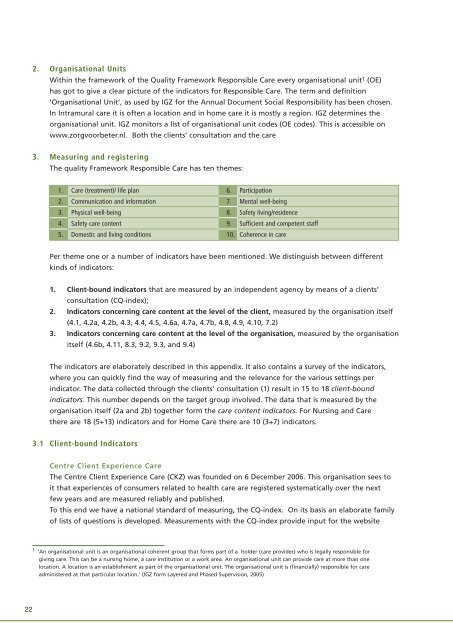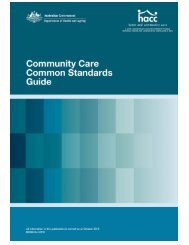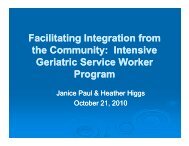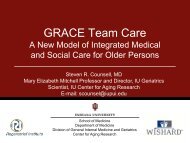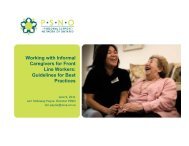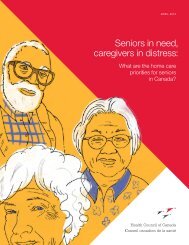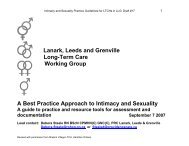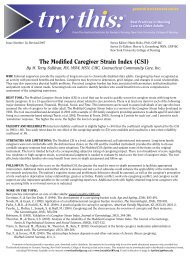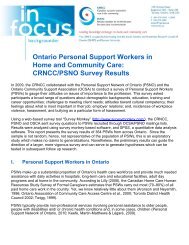Quality Framework Responsible Care - BioMed Central
Quality Framework Responsible Care - BioMed Central
Quality Framework Responsible Care - BioMed Central
Create successful ePaper yourself
Turn your PDF publications into a flip-book with our unique Google optimized e-Paper software.
2. Organisational Units<br />
Within the framework of the <strong>Quality</strong> <strong>Framework</strong> <strong>Responsible</strong> <strong>Care</strong> every organisational unit 1 (OE)<br />
has got to give a clear picture of the indicators for <strong>Responsible</strong> <strong>Care</strong>. The term and definition<br />
‘Organisational Unit’, as used by IGZ for the Annual Document Social Responsibility has been chosen.<br />
In Intramural care it is often a location and in home care it is mostly a region. IGZ determines the<br />
organisational unit. IGZ monitors a list of organisational unit codes (OE codes). This is accessible on<br />
www.zorgvoorbeter.nl. Both the clients’ consultation and the care<br />
3. Measuring and registering<br />
The quality <strong>Framework</strong> <strong>Responsible</strong> <strong>Care</strong> has ten themes:<br />
1. <strong>Care</strong> (treatment)/ life plan 6. Participation<br />
2. Communication and information 7. Mental well-being<br />
3. Physical well-being 8. Safety living/residence<br />
4. Safety care content 9. Sufficient and competent staff<br />
5. Domestic and living conditions 10. Coherence in care<br />
Per theme one or a number of indicators have been mentioned. We distinguish between different<br />
kinds of indicators:<br />
1. Client-bound indicators that are measured by an independent agency by means of a clients’<br />
consultation (CQ-index);<br />
2. Indicators concerning care content at the level of the client, measured by the organisation itself<br />
(4.1, 4.2a, 4.2b, 4.3, 4.4, 4.5, 4.6a, 4.7a, 4.7b, 4.8, 4.9, 4.10, 7.2)<br />
3. Indicators concerning care content at the level of the organisation, measured by the organisation<br />
itself (4.6b, 4.11, 8.3, 9.2, 9.3, and 9.4)<br />
The indicators are elaborately described in this appendix. It also contains a survey of the indicators,<br />
where you can quickly find the way of measuring and the relevance for the various settings per<br />
indicator. The data collected through the clients’ consultation (1) result in 15 to 18 client-bound<br />
indicators. This number depends on the target group involved. The data that is measured by the<br />
organisation itself (2a and 2b) together form the care content indicators. For Nursing and <strong>Care</strong><br />
there are 18 (5+13) indicators and for Home <strong>Care</strong> there are 10 (3+7) indicators.<br />
3.1 Client-bound Indicators<br />
Centre Client Experience <strong>Care</strong><br />
The Centre Client Experience <strong>Care</strong> (CKZ) was founded on 6 December 2006. This organisation sees to<br />
it that experiences of consumers related to health care are registered systematically over the next<br />
few years and are measured reliably and published.<br />
To this end we have a national standard of measuring, the CQ-index. On its basis an elaborate family<br />
of lists of questions is developed. Measurements with the CQ-index provide input for the website<br />
1 ‘An organisational unit is an organisational coherent group that forms part of a holder (care provider) who is legally responsible for<br />
giving care. This can be a nursing home, a care institution or a work area. An organisational unit can provide care at more than one<br />
location. A location is an establishment as part of the organisational unit. The organisational unit is (financially) responsible for care<br />
administered at that particular location.’ (IGZ form Layered and Phased Supervision, 2005)<br />
22


